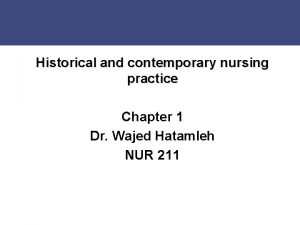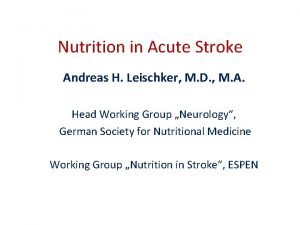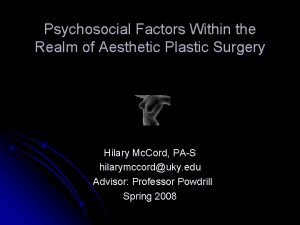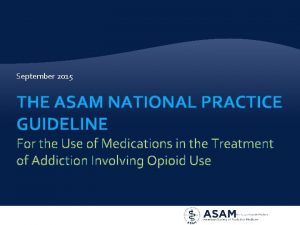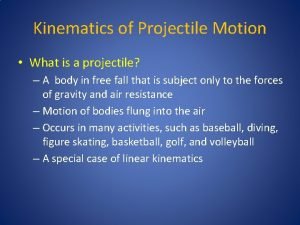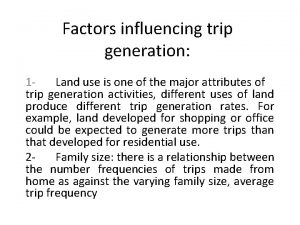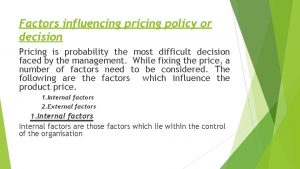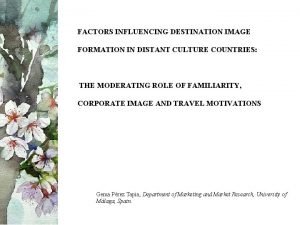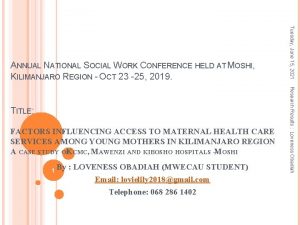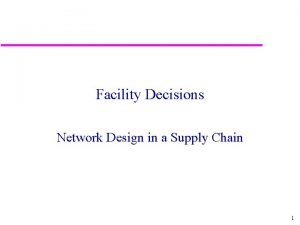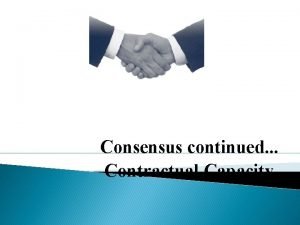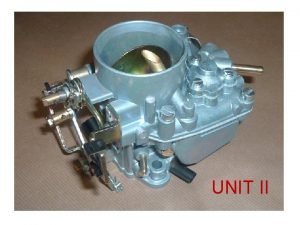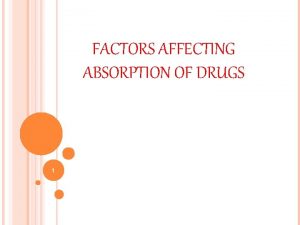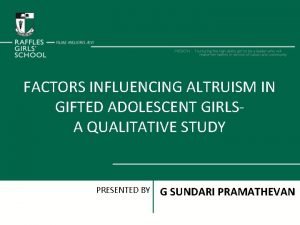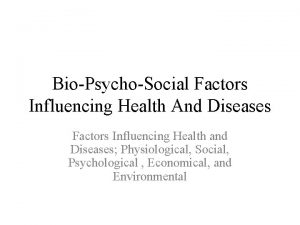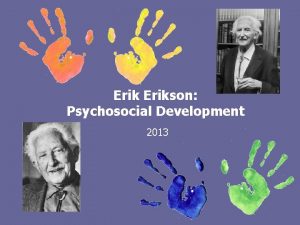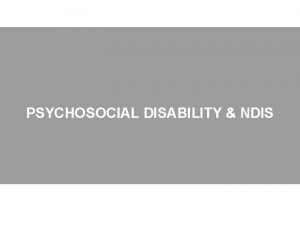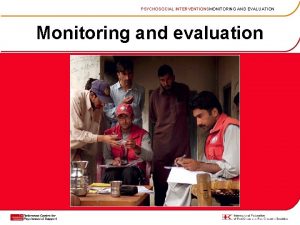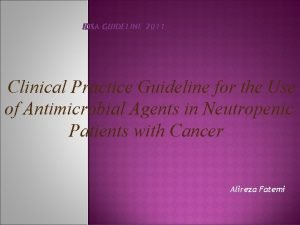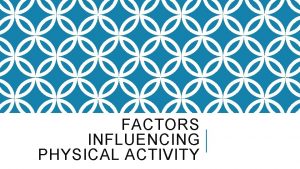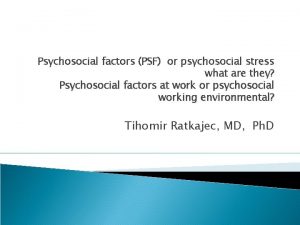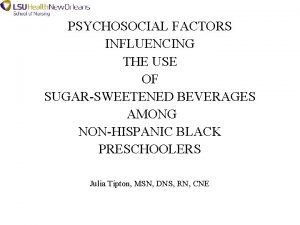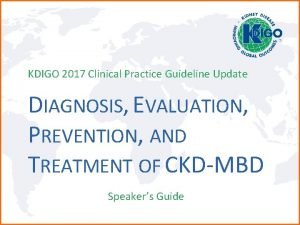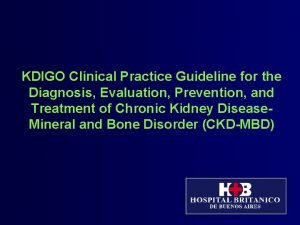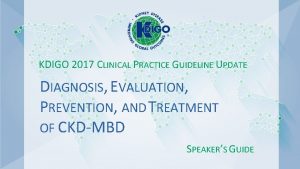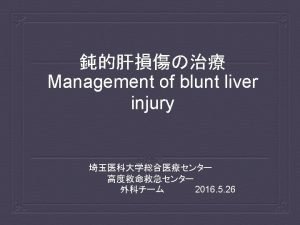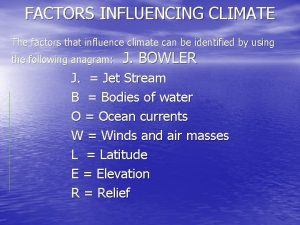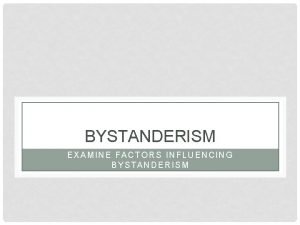Clinical Practice Guideline Evaluation of Psychosocial Factors Influencing
















![WORDING THE FINAL RECOMMENDATIONS GUIDELINE LANGUAGE In patients with [condition], X is recommended for… WORDING THE FINAL RECOMMENDATIONS GUIDELINE LANGUAGE In patients with [condition], X is recommended for…](https://slidetodoc.com/presentation_image_h2/5912c6709286b8d311470e8f460387e4/image-17.jpg)














- Slides: 31

Clinical Practice Guideline Evaluation of Psychosocial Factors Influencing Recovery from Adult Orthopaedic Trauma Adopted by the American Academy of Orthopaedic Surgeons (AAOS) Board of Directors December 6, 2019

The Major Extremity Trauma and Rehabilitation Consortium in collaboration with the American Academy of Orthopaedic Surgeons 2019 Clinical Practice Guideline for Evaluation of Psychosocial Factors Influencing Recovery from Adult Orthopaedic Trauma Steve Wegener, MA, Ph. D; Benjamin Keizerr, Ph. D; Erik Ensrud, MD; Ann Marie Warren, Ph. D, ABPP; Todd Swenning, MD FAAOS; Kelly Cozza, MD; David Benedek, MD; Wade Gordon, MD, FAAOS; Saloni Sharma, MD; Peggy Naas, MD, MBA, FAAOS; David Ring, MD, FAAOS; Atul Kamath, MD, FAAOS; Julie B. Samora, MD, Ph. D, MPH; Jayson Murray, MA, Kyle Mullen, MPH; Danielle Schulte, MS; Kaitlyn S. Sevarino, MBA, CAE; Barbara Krause; Connor Riley, MPH; Anne Woznica, MLIS, AHIP; Jennifer Rodriguez; Mary De. Mars; Ellen J. Mac. Kenzie, Ph. D © 2019 American Academy of Orthopaedic Surgeons

WHAT IS A CLINICAL PRACTICE GUIDELINE? Clinical Practice Guideline A clinical practice guideline is a series of recommendations created to inform clinicians of best practices, based on best available evidence © 2019 American Academy of Orthopaedic Surgeons

GOALS AND RATIONALE OF A CLINICAL PRACTICE GUIDELINE § Improve treatment based on current best evidence § Guides qualified physicians through treatment decisions to improve quality and efficiency of care § Identify areas for future research CPG recommendations are not meant to be fixed protocols; patients’ needs, local resources, and clinician independent medical judgement must be considered for any specific procedure or treatment © 2020 American Academy of Orthopaedic Surgeons

WHAT IS EVIDENCE-BASED MEDICINE? Evidence-Based Medicine is a Combination of: § Individual Clinical Experience § Best External Evidence § Patient Values and Expectations EBM Best External Evidence © 2020 American Academy of Orthopaedic Surgeons

WHAT IS EVIDENCE-BASED MEDICINE? Evidence-Based Medicine Evidence-based medicine is the conscientious, explicit, and judicious use of current best evidence from clinical care research in the management of individual patients Haynes, Sackett et al, 1996 Transferring evidence from research into practice Sacket et al, 1996, BMJ EBM: what it is and isn’t © 2020 American Academy of Orthopaedic Surgeons

IOM STANDARDS FOR DEVELOPING TRUSTWORTHY GUIDELINE This Photo by Unknown Author is licensed under CC BY-NC § Establish Transparency § Management of Conflict of Interest § Guideline Development Group Composition § Clinical Practice Guideline-Systematic Review Intersection § Establish Evidence of Foundations for and Rating Strength of Recommendations § Articulation of Recommendations § External Review § Updating © 2020 American Academy of Orthopaedic Surgeons

CLINICAL PRACTICE GUIDELINE PROCESS FLOWCHART 5. Literature Search and Review: Conduct systematic literature search, appraise quality of studies (staff); WG members review included literature for their assigned recommendations 1. Select CPG Topic 2. Formulate Work Group (WG): Representatives from AAOS/BOC/Other Organizations as appropriate WG members may have no relevant FCOI 4. In-Person Intro Meeting: Formulate PICO Questions, Set Inclusion Criteria (Completed by WG) 3. Seek Input on Question Topics: From patients, AAOS members, Key Informant Panel (a panel of content experts precluded from WG participation due to FCOI). 6. In-Person Final Meeting: Develop Final Recommendations; Review quality appraisals and evidence tables. Assign a grade/rating for each based on evidence (WG). Completed both prior to and during final in-person meeting. 7. Review Period: (3 weeks) Nominated Specialty Society Representatives, AAOS BOD, AAOS CORQ, AAOS EBQV, AAOS BOC and BOS, Key Informant Panel 10. Communication, Dissemination, and Implementation 9. Approval Process: The final CPG is reviewed and approved by the WG, EBQV, CORQ, and the AAOS Board of Directors 8. Response to Revew and Revisions: Chairs and AAOS Staff review and respond to review; revise the draft as needed; any revisions to recommendation language requires WG approval © 2020 American Academy of Orthopaedic Surgeons

FORMULATING PICOs “P” = Patient Population “I” = Intervention or variable of Interest “C” = Comparison “O” = Outcome © 2019 American Academy of Orthopaedic Surgeons

INCLUSION/EXCLUSION CRITERIA Standard inclusion criteria include: § § Must study humans Must be published in English Must be published in or after 1966 Can not be performed on cadavers Work group members define additional exclusion criteria based on PICO question © 2020 American Academy of Orthopaedic Surgeons

LITERATURE SEARCHES • Databases used: • MEDLINE • EMBASE (Excerpta Medica data. BASE) • Cochrane Central Register of Controlled Trials • Search using key terms from work group’s PICO questions and inclusion criteria • Secondary manual search of the bibliographies of all retrieved publications for relevant citations • Recalled articles evaluated for inclusion based on the study selection criteria © 2020 American Academy of Orthopaedic Surgeons

RESULTS OF QUALITY ASSESSMENT: STUDY ATTRITION FLOWCHART 6647 abstracts reviewed. Final search performed on January 4, 2019 5049 articles excluded from title and abstract review 1588 articles recalled for full text review 67 articles included after full text review and quality analysis 1521 articles excluded after full text review for not meeting the a priori inclusion criteria or not best evidence available © 2020 American Academy of Orthopaedic Surgeons

BEST EVIDENCE SYNTHESIS Include only highest quality evidence for any given outcome if available If there are fewer than two occurrences of an outcome of this quality, the next lowest quality is considered until at least two occurrences have been acquired. © 2020 American Academy of Orthopaedic Surgeons

ASSESSING QUALITY OF EVIDENCE • All included studies undergo a quality assessment. • Each study’s design is evaluated for risk of bias and receives a final quality grade, depending on the number of study design flaws. • Study quality tables are made available to the work group in the final data report and the final publication of the guideline © 2019 American Academy of Orthopaedic Surgeons

STRENGTH OF RECOMMENDATIONS STRENGTH OVERALL STRENGTH OF EVIDENCE STRONG Two or more HIGH Strength Studies with consistent findings for recommending for or against the intervention* MODERATE OR STRONG Evidence from two or more MODERATE quality studies with consistent findings, or evidence from a single HIGH quality study for recommending for or against the intervention* LIMITED, MODERATE OR STRONG CONSENSUS NO RELIABLE EVIDENCE STRENGTH VISUAL Evidence from one or more “Low” quality studies with consistent findings or evidence from a single “Moderate” quality study recommending for or against the intervention* In the absence of reliable evidence, the guideline work group is making a recommendation based on their clinical Opinion* *Recommendation strength can be upgraded or downgraded based on the application of the Et. D framework. © 2020 American Academy of Orthopaedic Surgeons

Incorporating the GRADE Evidence to Decision Framework into Recommendation Strengths • Benefits and Harms • Certainty of Evidence • Outcome Importance • Cost Effectiveness • Acceptability and Feasibility
![WORDING THE FINAL RECOMMENDATIONS GUIDELINE LANGUAGE In patients with condition X is recommended for WORDING THE FINAL RECOMMENDATIONS GUIDELINE LANGUAGE In patients with [condition], X is recommended for…](https://slidetodoc.com/presentation_image_h2/5912c6709286b8d311470e8f460387e4/image-17.jpg)
WORDING THE FINAL RECOMMENDATIONS GUIDELINE LANGUAGE In patients with [condition], X is recommended for… STRENGTH OF RECOMMENDATION STRONG In patients with [condition], X is suggested for… MODERATE In patients with [condition], X is an option for… LIMITED In the absence of reliable evidence, it is the opinion of this guideline work group that… CONCENSUS © 2020 American Academy of Orthopaedic Surgeons

TRANSLATING RECOMMENDATIONS IN A CPG STRENGTH OF RECOMMENDATION PATIENT COUNSELING TIME DECISION AIDS IMPACT OF FUTURE RESEARCH Strong Least important, unless the evidence supports no difference between two alternative interventions Not likely to change Moderate Less important Less likely to change Limited More Possible / Anticipates Consensus Most Important Impact unknown © 2020 American Academy of Orthopaedic Surgeons

FINAL MEETING The work group is charged with: § § Review of data summaries Final recommendation language Rationale and risk/harm construction Future research © 2019 American Academy of Orthopaedic Surgeons

VOTING ON THE RECOMMENDATIONS • Recommendations and recommendation strengths voted on by work group during final meeting • Approved and adopted by simple majority (60%) when voting on every recommendation • If disagreement, further discussion to whether the disagreement could be resolved © 2019 American Academy of Orthopaedic Surgeons

REVIEW PERIOD § Specialty societies are solicited for nominations of reviewers approximately six weeks prior to final meeting § CPG is also provided to: • AAOS Board of Directors • AAOS Council on Research and Quality • AAOS Committee on Evidence-Based Quality and Value • AAOS Board of Councilors • AAOS Board of Specialty Societies • 200 commentators have the opportunity to provide input into each CPG. § Recommendation changes required a majority vote by work group § A detailed report of all resulting revisions is published with the guideline document © 2020 American Academy of Orthopaedic Surgeons

CLINICAL PRACTICE GUIDELINE § FOR PSYCHOSOCIAL FACTORS § OVERVIEW Based on a systematic review of published studies Addresses the evaluation of psychosocial factors influencing recovery from adult orthopaedic trauma. § Additionally, this guideline addresses psychosocial factors influencing clinical, functional, and quality of life recovery following military and civilian adult orthopaedic trauma. § Highlights limitations in literature and areas requiring future research. § Trained orthopaedic surgeons and other surgical providers and rehabilitation specialists who partner in the care of patients with severe lower extremity trauma are the intended users. © 2020 American Academy of Orthopaedic Surgeons

Factors Associated with Patient Outcomes • It is recommended that clinicians evaluate the following factors, as they are associated with increased biopsychosocial limitations after adult orthopaedic trauma: • Anxiety • PTSD • Depression • Premorbid psychiatric conditions • Smoking • Lower education level • Less social support • Resilience Issues (i. e. Limited self-efficacy, less effective coping strategies) Strength of Recommendation: Moderate © 2020 American Academy of Orthopaedic Surgeons

ACKNOWLEDGEMENTS: Development Group Roster: Steve Wegener, MA, Ph. D, Non-Military Co-Chair Benjamin Keizer, Ph. D, Military Co-Chair Erik Ensrud, MD Ann Marie Warren, Pd. D, ABPP Todd Swenning, MD, FAAOS Kelly Cozza, MD David Benedek, MD Wade Gordon, MD, FAAOS Saloni Sharma, MD Peggy Naas, MD, MBA, FAAOS David Ring, MD, FAAOS Guidelines Oversight Chair: Atul Kamath, MD, FAAOS Julie B. Samora, MD, Ph. D, MPH, FAAOS/METRC Staff: Jayson Murray, MA Kyle Mullen, MPH Danielle Schulte, MS Kaitlyn S. Sevarino, MBA, CAE Barbara Krause Connor Riley, MPH Anne Woznica, MLIS, AHIP Jennifer Rodriguez Mary De. Mars Ellen J. Mac. Kenzie, Ph. D © 2020 American Academy of Orthopaedic Surgeons

PLEASE CITE CLINICAL PRACTICE GUIDELINE AS: American Academy of Orthopaedic Surgeons Evidence-Based Clinical Practice Guideline for Evaluation of Psychosocial Factors Influencing Recovery from Adult Orthopaedic Truama http: //www. orthoguidelines. org/topic? id=1030. Published December 6, 2019. © 2020 American Academy of Orthopaedic Surgeons

Free for both i. OS and Android or at www. orthoguidelines. org Provides easy access to all AAOS: • • • Clinical Practice Guidelines Full Guideline PDF’s Appropriate Use Criteria Case Studies Clinician Checklists Impactful Statements Plain Language Summaries Evidence-based Databases Evidence-based Methods, Appraisals and Standards © 2020 American Academy of Orthopaedic Surgeons

Easier access to AAOS Guidelines: § Sort Alphabetically by Topic § Sort Recommendations by Strength • (Strong, Moderate, Limited, Consensus) § Sort by Stage of Care § Search Across all CPGs via a Single Keyword Search Easier Access to Individual Recommendations: § View recommendations via shortened titles § Access to full recommendation & rationale § Links to references (Pub. Med) Clinical Practice Guidelines Now Available on Your Smartphone Download on the App Store Get it on Google play

Imaging Search across all CPG and AUC Via a Single Keyword Search © 2020 American Academy of Orthopaedic Surgeons

References provided for each recommendation Links to Pub. Med

Appropriate Use Criteria Tool

PUBLISHED CLINICAL PRACTICE GUIDELINES § § § § § § Acute Achilles Tendon Rupture Acute Compartment Syndrome Anterior Cruciate Ligament Injuries Carpal Tunnel Syndrome Diagnosis and Prevention of Periprosthetic Joint Infections Distal Radius Fractures Glenohumeral Joint Osteoarthritis Hip Fractures in the Elderly Limb Salvage or Early Amputation Osteoarthritis of the Hip Osteoarthritis of the Knee (Arthroplasty) Osteoarthritis of the Knee (Non-Arthroplasty) Osteochondritis Dissecans Pediatric Developmental Dysplasia of the Hip in infants up to Six Months Pediatric Diaphyseal Femur Fractures Pediatric Supracondylar Humerus Fractures Psychosocial Factors Influencing Trauma Recovery Prevention of Orthopaedic Implant Infections in Patients Undergoing Dental Procedures Rotator Cuff Injuries Surgical Site Infections VTE Disease in Patients Undergoing Elective Hip & Knee Arthroplasty Tranexamic Acid in Total Joint Arthroplasty (Endorsement) Use of Imaging Prior to Referral to a Musculoskeletal Oncologist (Endorsement) For additional information, please visit http: //www. orthoguidelines. org/ © 2020 American Academy of Orthopaedic Surgeons
 Aki kdigo
Aki kdigo Acromegaly an endocrine society clinical practice guideline
Acromegaly an endocrine society clinical practice guideline Factors influencing contemporary nursing practice
Factors influencing contemporary nursing practice Guideline clinical nutrition in patients with stroke
Guideline clinical nutrition in patients with stroke Relaxation response technique
Relaxation response technique Psychosocial and aesthetic factors
Psychosocial and aesthetic factors Asam national practice guideline
Asam national practice guideline Good physique and chemique
Good physique and chemique Oxidation weathering diagram
Oxidation weathering diagram What is a wage
What is a wage Physical factors influencing agriculture
Physical factors influencing agriculture Vertical component of projectile motion
Vertical component of projectile motion Factors influencing trip generation
Factors influencing trip generation Factors influencing pricing
Factors influencing pricing A model of destination image formation
A model of destination image formation Factors of communication process
Factors of communication process Factors influencing maternal health
Factors influencing maternal health Local factor affecting wound healing
Local factor affecting wound healing Factors influencing faculty staff relationship
Factors influencing faculty staff relationship Objectives of plant layout ppt
Objectives of plant layout ppt What are the factors influencing network design decisions
What are the factors influencing network design decisions Physical factors influencing agriculture
Physical factors influencing agriculture Factor affecting consensus
Factor affecting consensus Types of chemical weathering
Types of chemical weathering Distributor storage with last mile delivery
Distributor storage with last mile delivery Factors affecting oxygenation and ventilation
Factors affecting oxygenation and ventilation Physical factors influencing agriculture
Physical factors influencing agriculture When does the simple carburetor supplies rich mixture
When does the simple carburetor supplies rich mixture Factors influencing t&d
Factors influencing t&d Differentiated learning theories
Differentiated learning theories Ph partition theory
Ph partition theory Factors influencing altruism
Factors influencing altruism


